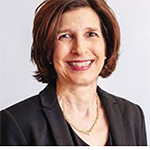
Dr. Bolster
ATLANTA—The rheumatology profession faces a severe shortfall of practitioners that threatens the ability to address patients’ needs. “Even if we doubled the number of positions for fellowship training, we wouldn’t meet the increasing demand on our workforce,” said Marcy B. Bolster, MD, associate professor of medicine at Harvard Medical School, Boston, and director of the Rheumatology Fellowship Training Program in the Division of Rheumatology, Allergy and Immunology at Massachusetts General Hospital. Dr. Bolster, who served as chair of the ACR Committee on Rheumatology Training and Workforce Issues, also had a leadership role in developing the graduate medical education component of the ACR Adult Rheumatology Workforce Study in 2015.1
A long-standing axiom is that the first step in solving a problem is recognizing a problem exists. If this is true, solutions are on the horizon. Rheumatology organizations and their members are well aware of the problem and are exploring solutions, said both Dr. Bolster and John Tesser, MD, FACR, FACP, adjunct clinical associate professor at Midwestern University College of Health Sciences, Glendale, Ariz. Both rheumatologists spoke at the 2019 ACR/ARP Annual Meeting session, Addressing the Rheumatology Workforce.
Achievable Goals?
Dr. Bolster outlined different programs across the U.S. aimed at attracting top-notch professionals to rheumatology. Dr. Tesser, also a practicing rheumatologist with Arizona Arthritis and Rheumatology Associates, is optimistic. “I believe the rheumatology workforce can potentially be catapulted up to a much higher number than by chipping away at it.” He proposed a concerted effort to attract a large number of advanced practice clinicians, including nurse practitioners (NPs) and physician assistants (PAs).2 Dr. Tesser prefers not to use the term advanced practice providers. “None of us like to be called providers. Clinician is a more elegant term and reflects a bit more respect for what we do.”
The 2015 ACR Workforce Study reported that in 2015, there were 4,997 rheumatology professionals but 6,115 were needed in the U.S.1 The study predicted that by 2030 the demand will be for 8,184 professionals, but the supply is expected to only be 3,455 clinicians. Part of the reason for the shortfall, said Dr. Bolster, is that 50% of rheumatologists are expected to retire in the next 10–15 years.1
Dr. Bolster said the number of fellows entering the workforce—not fellows in training (FITs)—has been fairly stable (210 in 2013–2014 and 214 in 2016–2017). But the number of fellows choosing rheumatology won’t be enough to fill the need. For example, in December 2017, the number of FITs on duty in Accreditation Council for Graduate Medical Education-accredited programs and in combined Specialty Graduate Medical Education programs in adult rheumatology totaled 457 and 82 in pediatric rheumatology.3 The following year numbers inched up 4.38% for adult and 9.76% for pediatric rheumatology (477 and 90, respectively). Also, only 4% of internal medicine residents entering specialties in 2017–2018 chose rheumatology.4
It’s not that fellows are shunning rheumatology. In the 2019 “match program,” rheumatology placed sixth as a preferred specialty.5 Dr. Bolster said the unfulfilled category in the match program might offer a slight door that could open for rheumatology. “There were 119 (33.2%) who did not match to any program. This is a huge number of potential new entrants into our workforce who didn’t get a position, because there weren’t enough positions for their preferred specialties.”
What Can Be Done
Dr. Bolster said one obvious solution is the expansion of fellowship programs, which, of course, requires funds and commitment. Fellowship grants available for 2020 include the Paula de Merieux Fellowship Training Award: $50,000 for an under-represented minority or a woman in rheumatology; the Amgen Fellowship Training Award: $50,000 per institution for partial fellow salary support; the Rheumatology Research Foundation Fellowship Training Award for Workforce Expansion: $100,000 over two years; and the Arthritis Foundation’s award: $150,000 over three years.
Dr. Bolster cautioned not to misconstrue the emphasis as being the number of employment slots. Rather, the goal is reducing long delays in receiving care and providing improved access to care for those in underserved areas. One way to alleviate this problem, she stated, is through telemedicine. “I think there’s a lot of promise in telemedicine. It can extend our reach particularly to underserved parts of the country,” she said.
Telemedicine can bridge the distance between patients and their doctors, thus improving access. She said studies show, in general, high patient satisfaction with telemedicine visits compared with in-person visits, and time and travel expenses are reduced.6 Disadvantages include the lack of resources for video access, mastery of the technology, compliance with the Health Insurance Portability and Accountability Act, medical license portability and malpractice insurance issues.
One initiative Dr. Bolster discussed as a possible model is Project ECHO (Extension for Community Healthcare Outcomes), which was launched in 2003 at the University of New Mexico.7 The ECHO model differs from other telemedicine models in which a specialist advises the patient. Instead, “telementoring” is used, employing a guided-practice model with the participating clinician retaining responsibility for managing the patient.
“In this way, technology is a leveraged resource for education. The system shares best practices to promote quality of care, while offering case-based learning and data collection to track outcomes,” said Dr. Bolster.
Rheumatology is one of five high-priority programs at Project ECHO. Between 2006 and 2014, 2,230 clinicians participated in the ECHO rheumatology program, with 1,930 continuing medical education credits awarded and 1,173 cases presented. The most common diagnoses were rheumatoid arthritis, fibromyalgia and systemic lupus erythematosus; “however, the broad spectrum of our diseases was covered,” said Dr. Bolster.
The ECHO rheumatology program also conducted 15 two-day mini residencies for primary care providers to learn about rheumatology clinical practice; 30 clinicians have participated and 21 have completed ACR online modules for certification.



